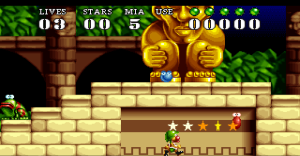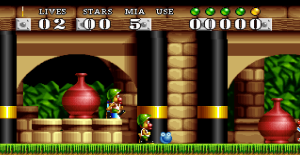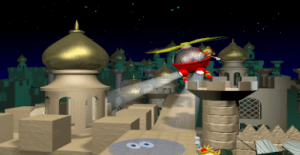Damnation is a Far West steampunk Third-Person Shooter/Platformer action game developed by Blue Omega Entertainment, Liquid Development and Point of View, Inc., and published by Codemasters in May 2009, for PC, PlayStation 3 and Xbox 360. The game originally started as an Unreal Tournament 2004 mod, sometimes named Damnation: Hell Breaks Loose, and was entered into Epic Games first Make Something Unreal contest:
Return to the West that never was in this genre-blending total conversion for Unreal Tournament 2004. Equipped with an array of steam-powered weaponry, acrobatic skills, and mystic Spirit Powers only you stand against a ruthless, mechanized foe. A self-styled “steampunk fantasy-western,” Damnation stands apart, providing the gaming community with not only fresh, new gameplay, but an untapped world to explore as well. Damnation is a new breed of gaming experience. As a first/3rd person action/adventure title, Damnation’s gameplay is unprecedented. Combining the immersion and precision-gunplay of a traditional first-person shooter like Call of Duty with the navigational puzzle design of 3rd-person adventure titles like Prince of Persia: Sands of Time, Damnation is a new paradigm in genre-blending gameplay.
In September 2005, the team wrote a postmortem on BeyondUnreal about what was going to be their next plan about the project:
We sit here, now, in the newly formed office of Blue Omega Entertainment and look forward to starting full production of the retail version of Damnation in just over a month. The lessons we learned from the prototype have strongly shaped the structure of this new development studio. Since our Grand Finals submission, we have completely stopped development of the mod. We have spent the last four months doing nothing but preproduction. We have meticulously planned out our design docs, production pipelines, and schedule. Everything that went wrong with the prototype has been addressed and reworked from the ground up.
Most prototypes aren’t as fully realized as Damnation: Hell Breaks Loose. We didn’t necessarily need to put as much effort and time as we did into creating polished art assets just to test out the game design. Given the chance to do it over, I don’t think we would change that though. Taking the art production pipeline as far as we did on the prototype showed us where all the holes were. It taught us what we could outsource and what absolutely had to stay in-house. We were able to make mistakes that on the full game could have cost us millions, but on the mod were only annoyances.
In the end, even though we didn’t win the license, we feel that the prototype was a success. We were able to test out our game design and get tons of great feedback from the mod community. We now know that we are more than capable of taking the Damnation concept to completion and we feel confident that it will be a great game. In fact, the lessons we learned about valuing quality over quantity ensure that whether the final game matches our current vision or not, it will be fun. We believe that that focus alone is enough to make it a success.
Blue Omega tried to pitch their Unreal Mod to develop it into a commercial game and when they found a publisher interested in the project, the team worked hard to expand Damnation into a full title for the then next gen consoles. But the development of this new version didn’t go as planned: officially revealed in March 2008 for a release planned in December of the same year, the title was pushed back in 2009 for a release in May. Damnation received unfavorable reviews by the press.
In January 2013, VentureBeat investigated with former Lead Game Designer Jacob Minkoff what went wrong during the development:
Damnation was intended to be something very special. The game germinated from a hybrid first/third-person action game entered into the first Make Something Unreal competition in 2004. While it didn’t win, production continued with a full retail release as the ultimate goal. Aspirations were high among the team, and its plans for the game were lofty.
Blue Omega was aiming high with Damnation. It wanted to create huge battlefields that player and adversary alike could traverse any way they saw fit. It was seeking to create both organic locations and enemies, throw the player into the mix, and watch the emergent gameplay spiral out of control in the most fantastic of ways. Things eventually did spiral, though no one, especially the player, benefited in the least.
“Damnation was a product of a green team that didn’t really know what they were doing. It was my first professional game development project; the same was true of many members of the core team.”
The eagerness of the team also led them to overlook the huge challenge set by the new console hardware they were developing for. “We were on the cusp of a new generation, and we learned lessons that have since become common knowledge in game development,” said Minkoff.
In trying to expand upon Damnation so dramatically while working with new hardware, Blue Omega tried to accomplish too much too soon. “Making a sprawling — theoretically — triple-A game on console and PC was simply too much for us to handle,” said Minkoff.
This problem was only exacerbated by the decision to outsource large portions of the game and maintain an uncommonly small in-house team. The strategy was originally intended to afford this core team the greatest level of flexibility and allow it to adapt throughout development. As Minkoff revealed, this simply was not the case in practice.
“Outsourcing was a problem,” he said. “You need the time, experience, and budget to turn on a dime — to throw out what you’ve made and try something else quickly, and within constraints. We did not have the resources or knowledge to do that at Blue Omega.”
This inflexibility, caused by inexperience and outsourcing, led to the game’s woefully protracted development cycle. Few games command four years to make, and when they do finally see release, it’s usually justified with high levels of polish and production value. This was the opposite for Damnation. The longer it stayed in development, the more out of touch and less impressive it became. Level architecture, A.I., textures, animations, movement, physics, audio mixing, sound effects, dialogue, cutscenes, acting, weapons, and general common sense all had their merits eroded over the years it took Damnation to gestate.
“In the end, you usually run out of time or money,” said Minkoff. “With Damnation, we ran out of both. One of the primary reasons why you see so much architectural reuse is because it was cheaper to pay for a retexture than all new geometry. It also took less time to do so, giving us more hope of us meeting our release date.”
It could have been a great game had the team been more experienced, focused, and time-efficient. Minkoff sees the silver lining: “Many games never ship at all because the investment to make the game simply pass console certification would be prohibitive. That it shipped at all is a triumph for Damnation’s team.”
His positivity likely emanates from where Damnation took him next and where he was able to take its fundamental concepts. After the game’s completion, Minkoff moved to Naughty Dog and designed some of the most memorable sections of the Uncharted sequels. There, he was finally able to realize his ambitions for Damnation thanks to an experienced team and appropriate resources.
That the similar yet vastly superior first Uncharted game was in development at the same time as Damnation and saw release two years earlier to critical acclaim is an irony that is not lost on Minkoff. Instead of wallowing in the past, however, he is looking toward the future and building upon his first game’s auspicious past.
“Everyone has to learn somewhere,” he said. “I learned on Damnation.”
More recently, someone claiming to be a close source from the developers wrote under a video by Youtuber Matt McMuscles:
I work for the guys who came up with and had it made. They hired a company to do the coding and worked with a publisher to get it out on the various platforms. It was coming along with issues, as the developer wasn’t listening to my boss, and then the publisher decided that they were tired of waiting and forced them to release it when it was half done. The original concept of the game was awesome, and would have been amazing if they actually made what he paid for. An alternate history of the US where the South won the Civil War, with the tension and conflicts that arise from having an enemy directly border you. With steampunk elements. It sounded really cool.
The retail version retains some of the mod’s gameplay such as the acrobatic moves and spirit vision.
The original Damnation 2004 mod can still be downloaded here.
Article updated by Daniel Nicaise
Images:
Videos:



